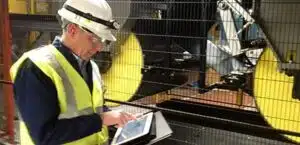The Provision and Use of Work Equipment Regulations 1998, more commonly referred to as PUWER, exist to protect workers from unsafe machinery and other work equipment. The definition of ‘work equipment’ is somewhat broad, so we will focus on the hazards associated with machines. What follows are ten things you might not know about PUWER – or that should be borne in mind if you are responsible for machinery safety within your organisation.
Steve Allen CMSE is leading the new Risk Assessment and PUWER Inspection service from Procter Machine Safety.
Key Insights for Machinery Safety and Compliance

Steve Allen CMSE is leading the new Risk Assessment and PUWER Assessment service from Procter Machine Safety.
1 – When are PUWER inspections required?
If you have already heard of PUWER inspections then you probably associate them with existing equipment. However, it should be remembered that equipment should be inspected (a) when it is installed and prior to its first use, (b) periodically thereafter, and (c) if there are any changes that could impact on the risks – such as the machine being repaired, modified or moved.
2 – You are unlikely to be prosecuted under PUWER
If there is an accident because of unsafe work equipment, you might be surprised to hear that the employer is unlikely to be prosecuted under PUWER. However, it is much more likely that the HSE (Health and Safety Executive) will pursue a prosecution under the Health and Safety at Work Act. In other words, don’t think that you can get away with having unsafe machines!
3 – There is no legal requirement to comply with standards
Machinery safety experts often refer to standards (BS, ISO, IEC, EN and so on) but there is no legal obligation for machines to comply with all relevant machinery safety standards. If an HSE inspector calls, he or she will expect to see that work equipment is safe and that the employer is following the Approved Code of Practice (ACOP)*, and the best way to comply with the ACOP is by ensuring machinery meets current standards.
- Safe use of work equipment – Provision and Use of Work Equipment Regulations 1998 – Approved Code of Practice and guidance, reference L22, published by TSO (The Stationery Office) on behalf of the HSE.
4 – A machine could have all of its original safety devices but it may not be ‘safe’
Attitudes to health and safety have changed enormously over the years. Legislation has been tightened and standards revised to improve safety and reduce the risk of accidents. A machine could still be in good condition and have all of its original guards and safety devices in working order, but that may not be good enough today. A thorough PUWER inspection should identify any aspects that need modifying or upgrading to meet today’s expectations – and to be honest, it often costs very little to do so.
5 – You don’t need to engage an expensive consultant to conduct a PUWER inspection
There is nothing to stop an employer conducting PUWER inspections in-house. However, whoever conducts the inspection should be competent to do so and it is fair to say that someone who is not familiar with the machinery and working practices – a person with a ‘fresh pair of eyes’ – often spots things that would otherwise be overlooked. Furthermore, when it comes to complex machinery, there is a strong argument in favour of using machinery safety experts who are familiar with the applicable machinery safety standards and, just as importantly, know what an HSE inspector will expect to see in terms of risks being reduced to ‘as low as reasonably practicable.’
6 – If a machine ‘fails’ a PUWER inspection, you don’t have to stop using it
If a machine is found to be very unsafe then, of course, it should not be used. But what if only minor faults are identified? It may well be that temporary measures can be put in place to reduce the risk until such time that the fault(s) can be rectified. Most importantly, a plan should be put in place stating what needs to be done and when.
7 – A PUWER inspection need not be time-consuming or expensive
Depending on the nature of the machine and the hazards involved, there is no need for a lengthy, time-consuming and detailed inspection entailing hours of costly downtime. The PUWER inspection should be proportionate to the risks. It is, however, essential that the inspection is documented, and photographs can be a very quick and unambiguous way of recording features such as physical guarding.
8 – A PUWER inspection needs to cover more than just the physical guards
As well as the physical machine guards, a PUWER inspection should also cover light guards, pressure-sensitive edges, emergency stop actuators and dust/fume extraction systems – to name just a few.
9 – PUWER also applies to ‘non-work’ equipment
PUWER exists to protect people and its scope is not restricted to production environments. For example, PUWER applies in schools, universities, hospitals, hotels, places of entertainment, and so on.
10 – A PUWER inspection is only a click away
If you think you have machinery that needs a PUWER inspection, Procter Machine Safety has experts who can help. We can provide a quote first, so you don’t need to worry about signing an open-ended and potentially expensive contract. If requested, we can also help you plan what needs to be done to rectify any non-compliances as cost-effectively as possible. Follow the link to find out more about our PUWER Inspection Service and to request a quote. You can also download our free PUWER White Paper.
